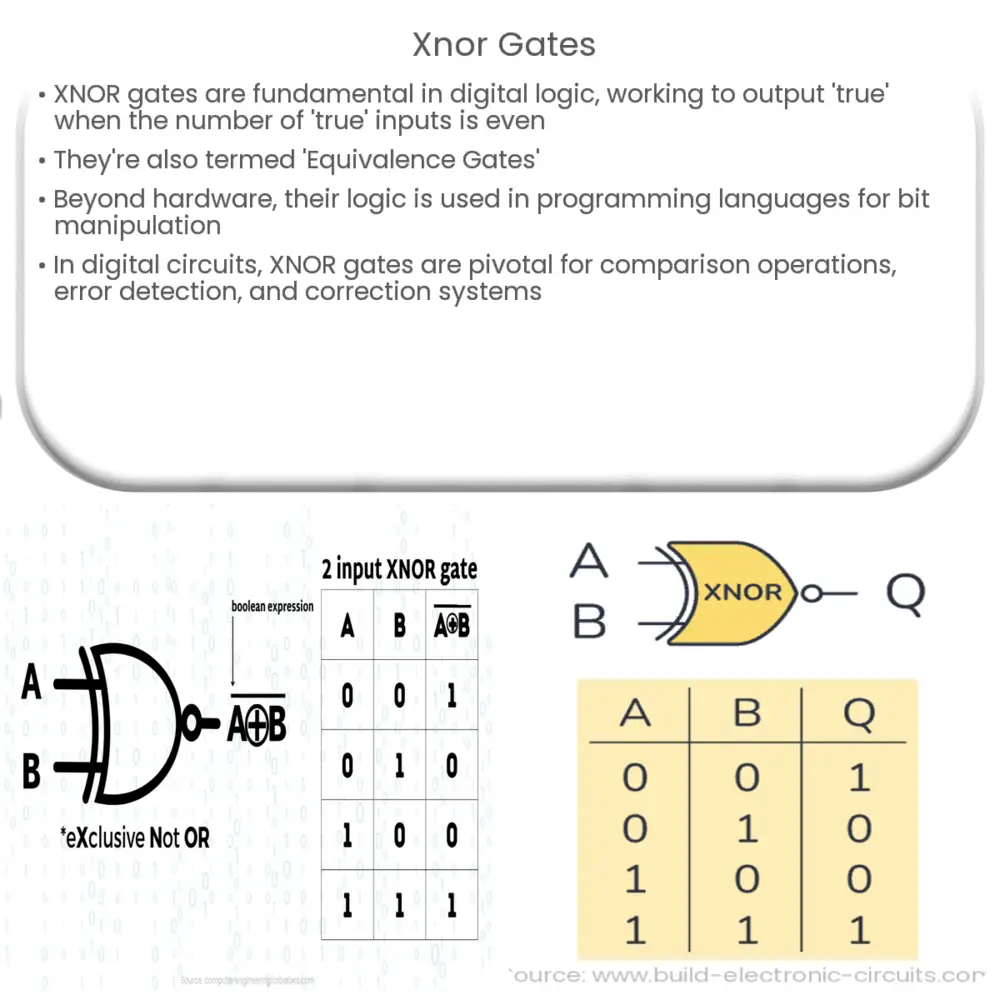Explore the fundamental role of XNOR gates in digital logic, their operations, real-world applications, and influence in programming.

An Introduction to XNOR Gates
Understanding the principles of digital logic is fundamental to the study of computer science and electronic engineering. At the heart of digital logic lies a set of basic components known as logic gates, one of which is the XNOR gate. The XNOR (exclusive NOR) gate is an essential element in the family of universal gates, alongside AND, OR, NOT, NAND, NOR, and XOR.
Working Principle of XNOR Gates
An XNOR gate operates with binary inputs and delivers outputs based on a specific logic. The term ‘exclusive’ infers that the gate delivers a high output (1) when an odd number of inputs are high. In contrast, the ‘NOR’ indicates that the output is ‘NOT’ true (‘0’) when any of the inputs are ‘OR’ed (high or ‘1’). However, the XNOR gate differs slightly from this logic.
In a two-input XNOR gate, the output is ‘true’ or ‘1’ if both inputs are the same, either ’00’ or ’11’. Conversely, if the inputs are different, the output is ‘0’. This property of outputting ‘true’ only when the number of ‘true’ inputs is even gives the XNOR gate its other name – the ‘Equivalence Gate’.
Symbol and Truth Table of XNOR Gate
The XNOR gate symbol in a digital circuit diagram is a combination of the XOR gate symbol with an inversion circle at the end, signifying the negation operation. Let’s understand this operation better with a truth table.
- 2-Input XNOR Gate:
- If input A=0, B=0, then Output (A XNOR B) = 1
- If input A=0, B=1, then Output (A XNOR B) = 0
- If input A=1, B=0, then Output (A XNOR B) = 0
- If input A=1, B=1, then Output (A XNOR B) = 1
This basic logic applies to all types of XNOR gates, regardless of the number of inputs. For a three-input gate, the XNOR logic follows the principle that if the number of ‘1’s is even, the output is ‘1’, and vice versa.
XNOR Gate Realization Using Other Gates
It’s worth noting that XNOR gates can be realized using other fundamental logic gates. It can be derived by combining an XOR gate with a NOT gate or by cleverly arranging AND, OR, and NOT gates.
Applications of XNOR Gates
XNOR gates, with their unique logical properties, are utilized in a variety of applications within digital circuits and systems. One notable use is in digital systems that require comparison operations. For instance, digital comparators, used extensively in central processing units (CPUs) and digital signal processors (DSPs), leverage the functionality of XNOR gates.
Moreover, parity generators and checkers, which are critical in error detection and correction in data transmission, also use XNOR gates. These devices help ensure data integrity during transmission by adding an extra bit (parity bit) to the data. The XNOR gate checks the parity and helps detect errors.
Implementation of XNOR Gates
XNOR gates are implemented in digital circuits using various technologies, including transistor-transistor logic (TTL), complementary metal-oxide-semiconductor (CMOS), and field-effect transistors (FETs). In CMOS technology, for instance, an XNOR gate is implemented using a combination of PMOS (p-type MOSFET) and NMOS (n-type MOSFET) transistors. These configurations provide efficient power usage and switching properties.
XNOR Gates in Programming
The concept of XNOR gates also finds relevance in programming and software development. Programming languages like C, C++, and Java use bitwise operators that effectively mimic the behavior of XNOR gates. Known as the equivalence operator, this can be handy in operations involving bit manipulation.
Conclusion
In summary, XNOR gates play a crucial role in digital electronics and computing. Their unique ability to deliver ‘true’ output when an even number of inputs are ‘true’ makes them a pivotal component in digital comparison, error detection, and correction systems. Beyond their physical implementation, the logical operation of XNOR gates also translates into the world of programming, further expanding their influence across the digital realm. As we continue to advance in the field of electronics and computer science, the role of such fundamental elements as the XNOR gate remains integral.

